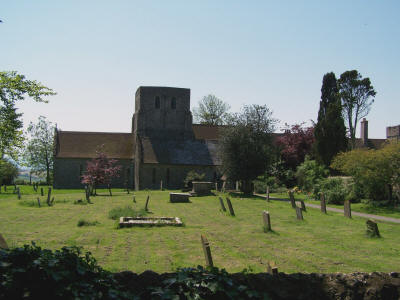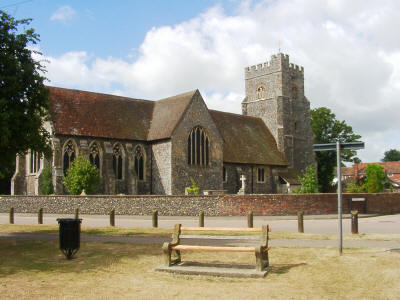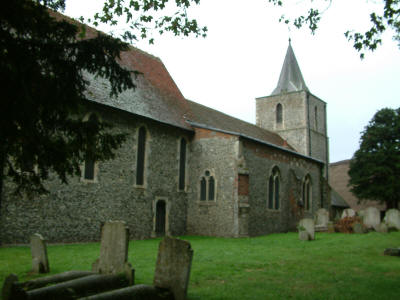Culpepper Places
Canterbury (Kent) Area of England
Canterbury Area Index
Separate Pages
Miscellaneous Places at Bottom of this Page

Miscellaneous Places
Temporary holding area for bits
and pieces of text and links until research is completed and pages developed for
each place.
Aldington-Lympne, Kent (West)
 |
Falconhurst. This but little known
house from a family of Falconer, in Edward VI reign, in the
possession of Thomas Culpeper.
(If this house is still standing, a photograph is desired.) |
 |
St.
Martin, Aldington (Photograph wanted)
We have not yet determined if any Culpepers appear in
monuments or registers of this church |
 |
 St.
Stephen's Church, Lympne St.
Stephen's Church, Lympne
We have not yet determined if any Culpepers appear in
monuments or registers of this church.
Photograph furnished by Keith Pearce, January 2011 |
 |
1831 Topographical Dictionary:
ALDINGTON, a parish partly in the liberty of
ROMNEY-MARSH, but chiefly in the franchise and barony of
BIRCHOLT, lathe of SHEPWAY, county of KENT, 5½ miles (W. by
N.) from Hythe: the former part contains 7 inhabitants, and
the latter 728. The church, dedicated to St.
Martin, displays the early style of English architecture, in
its general structure; but, among later additions, is a
finely ornamented window of five lights. |
 |
Lympne. Pronounced "Limm",
Lympne is a former Roman port which was called Portus Lemanis. The
Romans built a fort here in the 3rd century. It has been the
victim of erosion and neglect, but the remains now known as
Studfall Castle, can be visited. Only about 300 yards from there
is Lympne Castle, a fortified manor house originally built in the
14th century. It was largely rebuilt in this century but retains
its original character. From the castle are far-reaching views
over the Romney marsh, the Royal Military Canal and the Channel. (Hidden
Places of Kent.) |
Barfreston, Kent
 |
Fairfax Harrison: "In the course of
this last duty William10 moved his residence several
times, which explains why his third son, Martin, was entered at
Winchester (Kirby, supra) as 'of Barfriston' in east Kent.
It follows that it was not until the very end of his life that
William settled down at Wigsell. |
 |
St. Mary's Church (Photograph wanted)
We have not yet determined if any Culpepers appear in monuments
or registers of this church |
 |
1831 Topographical Dictionary:
BARFRESTON, a
parish in the hundred of EASTRY, lathe of ST. AUGUSTINE, county of
KENT, 6 miles (S. by E.) from Wingham, containing 115 inhabitants. The church, dedicated to St. Mary, presents a
fine specimen of Norman architecture, especially in the southern
porch, which is richly ornamented with varied moldings. (Besides the church of
Barfreston, which is one
of the most perfect specimens of pure Saxon in the kingdom, the
following are worthy of notice for their antiquity or curiosity,
viz., St. Mary's Dover, and those of Maidstone, Minster,
Patrixbourne, Reculver, Romney, and Sandwich.) |
 |
A maze of lanes deters heavy
traffic from entering Barfreston, a handsome village in the
farming country lying just north of the Lyminge Forest. The
immediate vicinity was once the site of several collieries, which
operated until the Second World War. Nature has taken over again,
however, and the dominant feature in the surrounding landscape is
farming. Barfreston's small Norman parish church is worth a
special visit. It is remarkable for its stone carvings, the best
of which are around the east door, representing an array of
creatures, scenes of Medieval life and religious symbols. Visitors
can obtain an explanatory leaflet from the pub opposite. There is
another curious feature of the church - the church bell is
attached to a yew tree in the churchyard. (The Hidden Places of
Kent) |
Beakesbourne, Kent
 |
Whitefriars. Granted to George
Harper, Esq. in 33 Henry VIII (circa 1542), he alienated Whitefriars, Canterbury the next year to Thomas Culpeper of
Bekesborne (otherwise unidentified) who two years later
passed them away to Thomas Browne. (Hasted II-147)
(If this house is still standing, a photograph is desired.) |
 |
St.
Peter's Church (Photograph wanted)
We have not yet determined if any Culpepers appear in
monuments or registers of this church |
 |
1831 Topographical
Dictionary:
BEAKSBOURNE, a parish within the Cinque-Port liberty of
HASTINGS, of which it is a member, though locally in the
hundred of BRIDGE and PETHAM, lathe of ST. AUGUSTINE,
county of KENT, 3½ miles (E.S.E.) from Canterbury,
containing 311 inhabitants. The church is dedicated to St. Peter. |
Chartham, Kent
 |
Howfield came to Mary Hales, co-heir
of John Hales. She entitled to her husband, Alexander Culpeper, Esq. He left an only daughter,
Anne (Family Tree only shows her as "Anne" with no
father), who
carried it into marriage to Sir John Culpeper12 of Wigsell.
He alienated it to the Fanes circa 1630.
(If this house is still standing, a photograph is desired.) |
 |
 St.
Mary's Church St.
Mary's Church
We have not yet determined if any Culpepers appear in
monuments or registers of this church.
Photograph furnished by Keith Pearce, January 2011 |
 |
1831 Topographical Dictionary:
CHARTHAM, a parish in the hundred of FELBOROUGH, lathe of
SCRAY, county of KENT, 3½ miles (S.W. by W.) from
Canterbury, containing, with the chapelry of Horton, which
is situated in the hundred of Bridge and Petham, 855
inhabitants. The church, dedicated to St.
Mary, is of early decorated architecture, with very fine
windows and some remains of richly stained glass: the roof
is of wood and the tower of flint, both being of later date
than the stone work: in the chancel lie the remains of Dr.
John Reading, chaplain to Charles I, and author of some
religious tracts. The river Stour, which is crossed near the
village by an ancient bridge of five arches, called
Shalmsford bridge, passes through the parish. Numerous
tumuli, raised over the slain in the decisive conflict
between Cęsar and Cassivelaunus, lie thickly scattered at
about three quarters of a mile from the church, on the road
to Canterbury, on opening which, urns, fibulę, &c. have
been discovered. |
Elmsted, Kent
 |
Elmsted Manor During the reign of Henry
VIII, the Manor of Elmsted was in possession of William Haut
of Bishopbourne, who left two daughters as co-heirs.
Elizabeth married Thomas Culpeper of Bedgebury who became
possessed of it. Passed by sale to Richard Hardres.
(Hasted 8-41)
(If this house is still standing, a photograph is desired.) |
 |
St.
James the Great, Elmsted (Photograph wanted)
We have not yet determined if any Culpepers appear in
monuments or registers of this church |
 |
1831 Topographical Dictionary of England
ELMSTED, a parish in the hundred of STOUTING, lathe of
SHEPWAY, county of KENT, 8 miles (E. by N.) from Ashford,
containing 454 inhabitants. The church is
dedicated to St. James. |
Hoath-Herne, Kent
 |
Ford Manor. Elizabeth, daughter of
William Hawte who lived during the reign of Henry VIII,
carried Ford Manor to her husband, Thomas Culpeper of
Bedgebury, who exchanged the manor with the Archbishop of
Canterbury for other premises.
National Grid Coordinates: TR 207 657
(If this house is still standing, a photograph is desired.) |
 |
1831 Topographical
Dictionary:
HERNE, a parish in the hundred of BLEANGATE, lathe of
ST. AUGUSTINE, county of KENT, 5¾ miles (N.E. by N.) from
Canterbury, containing 1675 inhabitants. The church, dedicated to St. Martin, has a tower and
other portions in the early style of English architecture,
with insertions in the later and decorated styles.
In the channel near the bay, numerous fragments of Roman
earthenware have been found, supposed to be the vestiges of
a cargo of pottery wrecked whilst the Romans were in
Britain. |
 |
St Martin of Tours, Herne (Photograph
wanted)
We have not yet determined if any Culpepers appear in
monuments or registers of this church |
 |
Holy
Cross Church, Hoath. (Photograph wanted)
We have not yet determined if any Culpepers appear in
monuments or registers of this church |
Littlebourne, Kent
 |
Wingate. Henry VIII granted Wingate
to Sir Christopher Hales. His youngest daughter Mary
entitled her husband Alexander Culpeper, Esq. to it, in
which name it continued until 22 Elizabeth when it was sold
to Thomas Fane. (Hasted IV-147)
(If this house is still standing, a photograph is desired.) |
 |
 St.
Vincent's Church. St.
Vincent's Church.
We have not yet determined if any Culpepers appear in
monuments or registers of this church.
Photograph furnished by Keith Pearce, January 2011 |
 |
1831 Topographical Dictionary
LITTLEBOURN, a parish in the hundred of DOWNHAMFORD, lathe
of ST. AUGUSTINE, county of KENT, 4¼ miles (E.) from
Canterbury, containing 698 inhabitants. The church is dedicated
to St. Vincent. A branch
of the river Stour passes by
the village. |
 |
Include Hidden Places of
Kent page 172. |
Nonington, Kent
 |
St. Albans Court. Mary Hales, one of
three co-heirs, carried St. Albans Court to her husband,
Alexander Culpeper, who alienated it to his eldest brother,
Sir Thomas Culpeper of Bedgebury, who sold it in 3 William
and Mary (circa 1692) to Hammond. (Hasted 9-255)
(If this house is still standing, a photograph is desired.) |
 |
St.
Mary the Virgin (Photograph wanted)
We have not yet determined if any Culpepers appear in
monuments or registers of this church |
 |
1831 Topographical Dictionary of England
NONINGTON, a parish in the hundred of WINGHAM, lathe of
ST. AUGUSTINE, county of KENT, 4¼ miles (S. by E.) from
Wingham, containing 730 inhabitants. The church, dedicated to
St. Mary, is principally in the early style of English
architecture. |
Preston, Kent
 |
Macknar (Makenade). Property of
Thomas
Culpeper of Bedgebury in late Henry VIII.
(If this house is still standing, a photograph is desired.) |
Stowting, Kent
 |
St.
Mary the Virgin (Photograph
wanted)
The Rev. Richard Alleyne, D.D.
(1572-1651) was the Vicar of Stouting and the father of
Margaret Alleyne. Margaret married the Rev. William Culpeper
of Wichling and they are the progenitors of the Culpepers of
Barbados. We have not yet determined if any Culpepers appear
in monuments or registers of this church. |
 |
1831 Topographical Dictionary:
STOUTING, a parish in the hundred of STOUTING, lathe of SHEPWAY,
county of KENT, 8 miles (E. by S.) from Ashford, containing 236
inhabitants. The
church, dedicated to St. Mary, is principally in the early style
of English architecture. The parish is bounded on the east by the
Roman Stane-street, and a branch of the river Stour rises here. In
the neighbourhood is a mound overgrown with wood, around which was
a double moat, but the origin of it is now buried in obscurity.
Some urns and Roman coins have been discovered in this parish. |
Swalecliffe, Kent
 |
Swalecliff Manor. During reign of Henry VIII, Mary,
daughter of Sir Christopher Hales, entitled Whitstaple (Whitstable) to
her husband, Alexander Culpeper in whose name it continued
until 22 Elizabeth when it was passed to Thomas Fane.
(Hasted 8-520)
(If this house is still standing, a photograph is desired.) |
 |
1831 Topographical Dictionary of England
SWALECLIFFE, a parish in the hundred of BLEANGATE, lathe
of ST. AUGUSTINE, county of KENT, 6½ miles (N.) from
Canterbury, containing 143 inhabitants. The church is dedicated to St.
John the Baptist. |
 |
St. John the Baptist, Swalecliff
(Photograph wanted)
We have not yet determined if any Culpepers appear in monuments or
registers of this church |
|
Last Revised:
02 Jan 2015
|
|